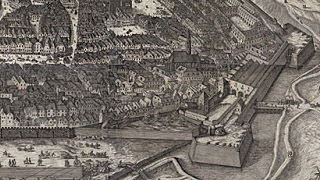The Period of the Turkish Sieges (1529 to 1683) - History of Vienna
First Turkish siege
In 1529 the city was besieged by the Turks. Although Vienna was not conquered, the siege was to have a dramatic impact on its physical structure. As early as 1530 work was undertaken to replace the now inefficient medieval city walls by modern fortifications and bastions, built on the Italian model. The suburbs had suffered the worst damage in 1529. Much of the building activity in the city until the mid-17th century concentrated on the fortifications. This also included the provision of a wide strip of land around the city, the so-called "glacis", which was to be kept clear of construction. But the contemporary topography was also, to a large extent, shaped by the building of monasteries, which had meanwhile begun to mirror the architectural upswing of the suburbs. At the same time, a growing Baroque element became noticeable in the cityscape of the early 17th century.
Imperial residence
The successful repulsion of the Turkish besiegers in 1529 had earned the city great international prestige. Travelogues and descriptions from the 16th century already testify to the metropolitan character of Vienna with strikingly tall buildings, but also narrow lanes, and altogether vibrant urban life. However, this also marked the beginning of the end of late medieval burgher autonomy. The renewed rise to glory of the Habsburgs, who returned to being Holy Roman Emperors in 1438, left little space for that. Even the beginnings of Vienna, under the Babenbergs, had been marked by the city's role as a residence, and this tendency became more strongly apparent still with the dawn of the early modern age. At the time, Vienna became the capital of the Holy Roman Empire and the residence of the Emperor. This is reflected not least in the fact that all building activity was dominated by the court, the aristocracy and the church. The court resided at Hofburg Palace, to which were added, from the 17th and 18th centuries, summer residences in the suburbs (Schönbrunn Palace). The aristocratic families built their palaces in the city and the suburbs, emulating court styles. The church was closely linked with the sovereign in responding to the religious reform ideas emerging and spreading in the 16th century, and commissioned a veritable spate of monasteries. Such building activities reflected the ownership situation in the city, the urban area being held by numerous landlords and the city administration being only one of them.
Second Turkish siege
The second Turkish siege, in 1683, again affected the physical and building structure of the city drastically. Although the combination of modern fortifications and valour on the part of the city's defenders had allowed the city to withstand the onslaught. The city walls as well as individual buildings in the inner city suffered severe damage. The suburbs were a shambles.
While the consequences of the 1529 siege had consisted mostly in the rebuilding of the protective wall around the city, the termination of the 1683 siege sparked off a veritable boom for the architectural development of the city in general. While the fortifications were rebuilt as a matter of course, the whole of the city became steeped in Baroque splendour. More and more of the construction activity shifted to the outskirts and suburbs, which were ringed by a generous outer circle of city defences, the so-called "Linienwall", in 1704. While, at the outset, military considerations had prevailed, the foremost purpose of the wall in subsequent years proved to be that of a tax border.
City of Vienna | Municipal and provincial archives of Vienna
Contact form


